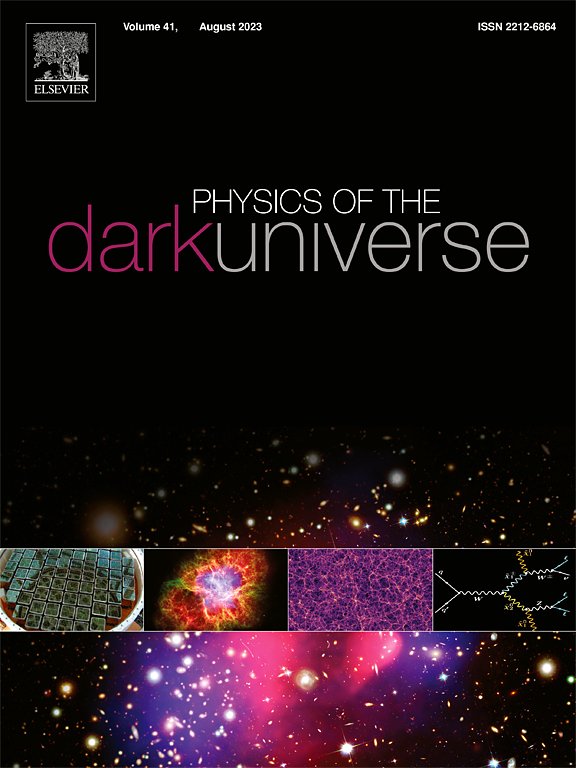Limiting the Yukawa gravity through the black hole shadows of Sgr A* and M87*
IF 6.4
2区 物理与天体物理
Q1 ASTRONOMY & ASTROPHYSICS
引用次数: 0
Abstract
Recently, the EHT collaboration unveiled the shadow images of the supermassive black hole (SMBH) M87* and Sgr A*, with angular radii of as and as, respectively. These observations are consistent with the shadow of a Kerr black hole in general relativity (GR). Observations of the shadow of SMBHs can be used to test modified gravity theories, including Yukawa gravity, in extremely strong fields. In this paper, we illustrate the shadows of Yukawa black holes, showing that their sizes are significantly influenced by the Yukawa parameters and . Using the EHT observations of M87* and Sgr A*, we obtain constraints on the Yukawa parameters. For Sgr A*, Keck and VLTI provide different priors on its gravitational radius. The Sgr A* shadow yields for AU with the Keck prior, while with the VLTI prior. As decreases, the constraints weaken, reaching (Keck prior) and (VLTI prior) at AU. For M87*, with a mass significantly larger than Sgr A*, this system can only put constraints on at larger . For AU, the EHT observation of M87* yields . No significant deviation from GR is detected in our analysis. Additionally, we explore potential constraints using the next-generation VLBI, like ngEHT and the Black Hole Explorer (BHEX), which promise the detection of the second ring of photons. The improved angular resolution and the measurements of the second ring could substantially refine constraints on the Yukawa parameters, enhancing our ability to test deviations from GR in the strong-field regime.
通过人马座A*和M87*的黑洞阴影限制汤川引力
最近,EHT合作公布了超大质量黑洞(SMBH) M87*和Sgr A*的阴影图像,角半径分别为42±3 μas和48.7±7.0 μas。这些观测结果与广义相对论(GR)中克尔黑洞的阴影相一致。对SMBHs阴影的观测可以用来测试修正的引力理论,包括汤川引力,在极强的磁场中。在本文中,我们举例说明汤川黑洞的阴影,表明它们的大小受到汤川参数λ和κ的显著影响。利用M87*和Sgr A*的EHT观测,我们得到了汤川参数的约束条件。对于人马座A*, Keck和VLTI提供了不同的引力半径先验。Keck先验对λ>;1 AU的Sgr A*影的κ=−0.04−0.10+0.09,VLTI先验对Sgr A*影的κ=−0.08−0.06+0.09。随着λ的减小,约束减弱,在λ=0.1 AU时达到- 0.37<κ<0.17 (Keck先验)和- 0.47<κ<0.04 (VLTI先验)。对于质量明显大于Sgr a *的M87*,该系统只能在较大λ处对κ施加约束。对于λ>;1.5×104 AU, M87*的EHT观测值为κ=−0.01−0.17+0.17。在我们的分析中没有发现与GR的显著偏差。此外,我们使用下一代VLBI探索潜在的限制,如ngEHT和黑洞探测器(BHEX),它们有望探测到光子的第二环。角分辨率的提高和第二环的测量可以大大改善汤川参数的约束,增强我们在强场条件下测试GR偏差的能力。
本文章由计算机程序翻译,如有差异,请以英文原文为准。
求助全文
约1分钟内获得全文
求助全文
来源期刊

Physics of the Dark Universe
ASTRONOMY & ASTROPHYSICS-
CiteScore
9.60
自引率
7.30%
发文量
118
审稿时长
61 days
期刊介绍:
Physics of the Dark Universe is an innovative online-only journal that offers rapid publication of peer-reviewed, original research articles considered of high scientific impact.
The journal is focused on the understanding of Dark Matter, Dark Energy, Early Universe, gravitational waves and neutrinos, covering all theoretical, experimental and phenomenological aspects.
 求助内容:
求助内容: 应助结果提醒方式:
应助结果提醒方式:


